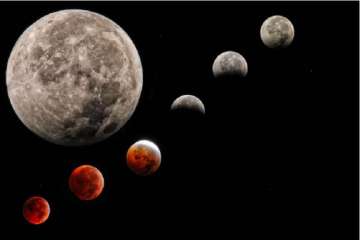Stargazers all across the world are all set to witness a trifecta of events on January 20 and 21 which includes a total lunar eclipse, super blood moon and a 'Wolf Moon' also known as the Super Blood Wolf Moon.
The Super Blood Moon is a phenomenon wherein the Moon appears particularly large and bright with a reddish glow. It is slated to appear in the night sky around all parts of the world on January 20 and 21. Wolf Moon is the name given by native Americans to a full moon that appears in the middle of winter.
This is the last total lunar eclipse until May 26, 2011. The previous lunar eclipse took place on July 27 last year.
Super Blood Moon happens during a total lunar eclipse when the Earth passes in between the Sun and the Moon, blocking the Sun’s light from falling directly on the Moon. However, the little light that manages to pass from the edges of the Earth’s atmosphere lit up the Moon’s surface and makes it look red.
During a total lunar eclipse, the Sun, Earth and the Moon are perfectly lined up. Also, a lunar eclipse only takes place when there is a full Moon.
The Moon appears larger and brighter during a Super Moon given it is closer than usual to the Earth.
SUPER BLOOD WOLF MOON LUNAR ECLIPSE: WHERE ALL WILL IT BE VISIBLE
This rare event will not be visible from across most parts of Asia, including India, though it can be viewed from across Americas, Greenland, Iceland, western Europe, and western Africa. People in eastern Africa and eastern Europe will only get to see the partial lunar eclipse.
SUPER BLOOD WOLF MOON LUNAR ECLIPSE: TIMINGS
The total lunar eclipse will start at 11:41 pm ET on January 20, which is around 10:11 am on January 21 in India. This phenomenon will last for 62 minutes.
The entire event, which includes total as well as partial lunar eclipse will reportedly last for three and a half hours.

